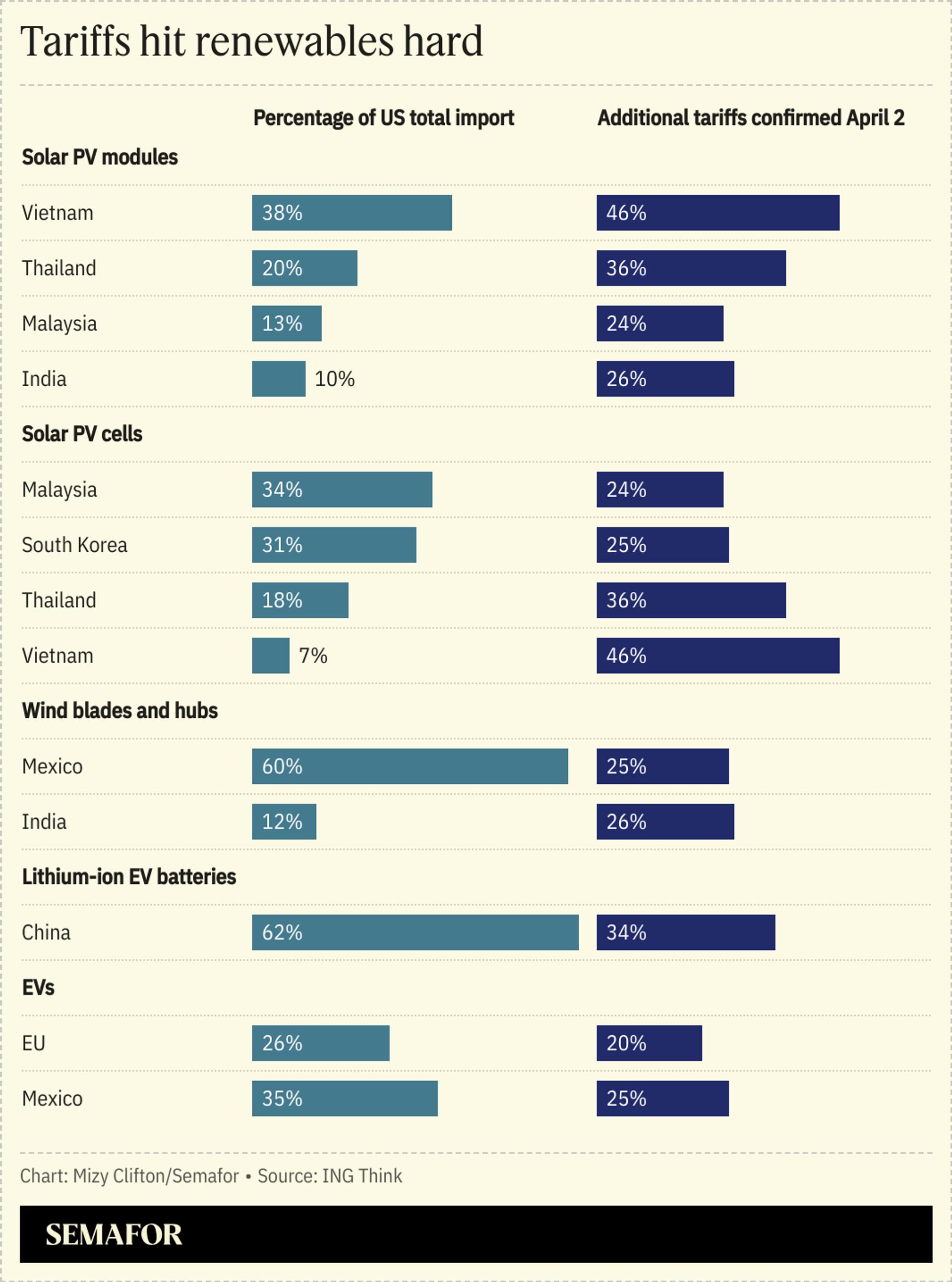The News
Sweeping global tariffs announced by US President Donald Trump this week will significantly raise the costs of renewable energy, making it harder for US big tech companies to meet their data center energy needs.
Although the clean energy tax credits implemented under President Joe Biden sparked a resurgence of investment in domestic climate tech manufacturing, the renewable energy industry is still predominantly reliant on imports of hardware such as solar panels, wind turbine components, and EV batteries — and will be for the foreseeable future. The new tariffs hit China and Southeast Asian countries that are critical suppliers of those goods particularly hard.
Higher costs will be passed on to energy consumers at a moment when, as NextEra Energy CEO John Ketchum recently told Semafor, renewables are still the cheapest and most readily available solution to the looming US power deficit. Tariffs on critical minerals, steel, aluminum, and components for power transformers will also make energy projects of all kinds more expensive.

In this article:
Tim’s view
Trade wars are bad for the energy transition. It’s clear that the fastest route to a lower-carbon economy is through global trade. That may not be a priority for the Trump administration, but low-cost energy ostensibly is. The tariffs do exempt imported oil and gas, a recognition that there are limits to how much domestic drilling can replace imports without causing untenable consumer price hikes.
But when it comes to the electricity market, the US needs every possible electron it can get, for the benefit of data centers and many other end users. Tariffs won’t make it any easier to build gas turbines, which already face extensive manufacturing backlogs. Renewables are a necessary near-term solution even if you don’t care about emissions. Tariffs might make some sense if they provide breathing room for domestic energy hardware manufacturers to catch up. And yet the Trump administration is actively undermining its support for the very same advanced energy technologies in which the US has the best chance of being competitive with China; the Department of Energy is reportedly considering a plan to withdraw funding for a variety of hydrogen, carbon capture, utility-scale energy storage, and long-distance transmission projects.
“To flip the script, we’ll have to do a lot more than tariffs,” Varun Sivaram, director of the Climate Realism Initiative at the Council on Foreign Relations and the former chief strategy officer at wind manufacturer Ørsted, told Semafor. “There is still an opportunity for the US to build globally competitive [new energy] industries. We desperately need to do that, but these tariffs are insufficient to accomplish it. What’s actually required is a suite of policies focused on supporting innovative American industries so they can be competitive at home and then exported around the world.”
If Trump is keen to see more domestic manufacturing in any sector, causing an increase in electricity prices is highly counterproductive, since those costs are already one of the main factors that keep manufacturers out of the US. Moreover, reshoring only makes sense if it happens at every point of the production chain. If the US wants to manufacture more energy equipment, it also needs more mining and more raw material processing, which in the best case will take many years to bring online.
Know More
The fact that tariffs also landed on key customers for US liquified natural gas exports, including Europe and Japan, suggests that the strategy some had embraced — and that Trump had earlier encouraged — of avoiding tariffs by buying more US fossil fuels hasn’t yet paid off.
The tariffs, in their current form, are also a missed opportunity for the US to forcibly drive down emissions in other countries, Sivaram said: “Imagine if these tariffs had been levied with the principal goal of getting China and emerging economies to reduce coal burning. We may actually have substantial success given the economic concessions we’ve already managed to extract through potential tariff threats.”
Room for Disagreement
Renewables still have the benefit of federal tax credits, meaning a portion of the higher costs to build them will be borne by taxpayers, not directly by energy consumers. And in the case of solar power, at least, production costs in Asia are so low, and falling all the time, that it could remain cost-competitive even with a steep trade barrier, said George Strobel, CEO of renewable energy impact investor Monarch Private Capital.
Notable
- US tariffs on South Korea and Japan will hand China an even greater advantage in EV production. Korean and Japanese battery makers are vital suppliers for US automakers, Bloomberg’s David Fickling writes, and they’re “integrated into domestic auto industries that will struggle to survive without exports.”
